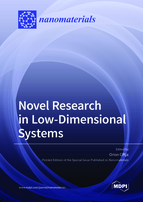Novel Research in Low-Dimensional Systems
A special issue of Nanomaterials (ISSN 2079-4991). This special issue belongs to the section "Theory and Simulation of Nanostructures".
Deadline for manuscript submissions: closed (30 November 2022) | Viewed by 20780
Special Issue Editor
Interests: strongly correlated electron systems; low-dimensional systems; two-dimensional electron gas; integer quantum hall effect; fractional quantum hall effect; nanoscale semiconductor quantum dots; nanoscale molecular magnetism; Monte Carlo simulations
Special Issues, Collections and Topics in MDPI journals
Special Issue Information
Low-dimensional systems exhibit unique properties that have attracted considerable attention. Notably, low-dimensional systems and devices are already featuring in several emerging technologies and advanced applications. We invite authors to contribute original research articles on the fundamental and applied aspects of physics in low-dimensional systems, two-dimensional electron systems, the quantum Hall effect, quantum dots, quantum wires, graphene, thin films, novel nanoscale devices, etc. Both theoretical and experimental contributions are invited. The aim of the issue is to provide an overview of current research in low-dimensional systems which show a large variety of scientifically fascinating and technologically important phenomena. Potential topics include but are not limited to:
- Two-dimensional electron gas and topological insulators;
- Integer and fractional quantum Hall effects;
- Spin–orbit interaction and spin-related phenomena;
- Quantum dots, wires, and mesoscopic systems;
- Nanostructures (graphene, carbon nanotubes, etc.) and thin films;
- Characterizations of nanomaterials, including theoretical and numerical methods;
- New frontiers in low-dimensional systems.
Prof. Dr. Orion Ciftja
Guest Editor
Manuscript Submission Information
Manuscripts should be submitted online at www.mdpi.com by registering and logging in to this website. Once you are registered, click here to go to the submission form. Manuscripts can be submitted until the deadline. All submissions that pass pre-check are peer-reviewed. Accepted papers will be published continuously in the journal (as soon as accepted) and will be listed together on the special issue website. Research articles, review articles as well as short communications are invited. For planned papers, a title and short abstract (about 100 words) can be sent to the Editorial Office for announcement on this website.
Submitted manuscripts should not have been published previously, nor be under consideration for publication elsewhere (except conference proceedings papers). All manuscripts are thoroughly refereed through a single-blind peer-review process. A guide for authors and other relevant information for submission of manuscripts is available on the Instructions for Authors page. Nanomaterials is an international peer-reviewed open access semimonthly journal published by MDPI.
Please visit the Instructions for Authors page before submitting a manuscript. The Article Processing Charge (APC) for publication in this open access journal is 2900 CHF (Swiss Francs). Submitted papers should be well formatted and use good English. Authors may use MDPI's English editing service prior to publication or during author revisions.
Keywords
- Low-dimensional systems
- Two-dimensional electron gas
- Integer and fractional quantum Hall effects
- Topological insulators
- Spintronics
- Quantum dots
- Mesoscopic systems
- Graphene
- Thin films
- Nanostructures







